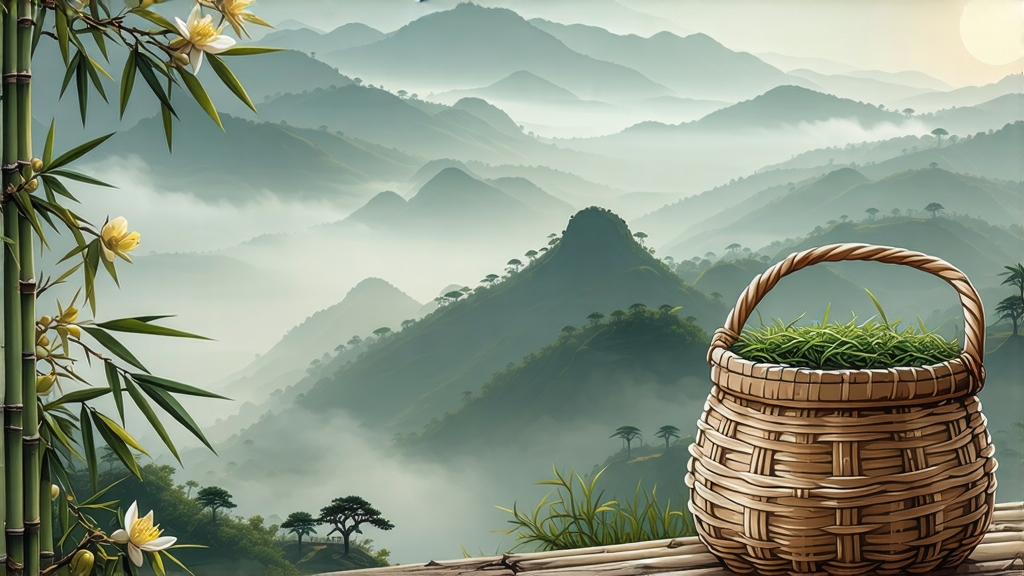
If green tea is the fresh-faced youth of Chinese tea and pu-erh the wise elder, then yellow tea occupies the quiet scholar who speaks little yet carries centuries of courtly secrets. Among the three surviving classic yellow teas, Meng Ding Huang Ya from Sichuan’s Mt. Meng enjoys the most continuous written pedigree, yet remains the least encountered outside China. This essay invites the international reader into the cloud-veiled gardens of Ya’an, tracing the bud-to-cup journey of a tea once reserved for Tang-dynasty emperors, nearly lost during the wars of the twentieth century, and now cautiously reborn through small family workshops.
-
Historical echoes
Mt. Meng, “the rain-making peak,” rises just where the Tibetan Plateau plunges toward the Sichuan basin. Monsoon clouds stall here 280 days a year, bathing the slopes in a drifting moisture that Buddhist monks interpreted as celestial breath. The first mention of “yellow sprout” appears in 850 CE in the Tang national register of tributes, ordered by Emperor Xizong after a court physician praised the bud’s ability to “clear the alcohol fire and brighten the imperial sight.” During the Song, carriage loads of early-spring buds traveled the post-road to Bianjing along with rhinoceros horn and Shu brocade; the tea was steamed, pressed, and stamped with the character “huang,” distinguishing it from the simultaneously shipped green cakes. By Ming times the technique had shifted to loose leaf, and the Qing court fixed the annual levy at 400 jin (240 kg), an impost lighter than Longjing’s but heavier than Keemun’s, signifying prestige rather than volume. Republican-era turmoil broke the chain; gardens were abandoned to opium poppies, and the yellowing craft survived only because three monks of the Meng Ding Zen temple memorized the steps as a chanting code. When the Ya’an Tea Company re-established experimental plots in 1958, engineers had to reconstruct the process from those chants and a single 1879 illustrated album found in a Chengdu antique stall. -
Micro-terroir and cultivar
The gardens sit between 950 m and 1,350 m on Pre-Cambrian phyllite soils rich in flaky minerals that drain quickly yet retain surface humidity. Average annual temperature is 14.7 °C; diurnal range in April can exceed 12 °C, locking floral volatiles inside the tender leaves. The traditional cultivar is a local shrub-type Camellia sinensis var. sinensis dubbed “xiao-ye-zhong” (small-leaf stock) whose spring bud weighs barely 0.18 g, half that of Fuding Da Bai, but contains 4.7 % theanine and an unusually high ratio of soluble arginine, the molecular source of the tea’s signature “sweet corn milk” note. Recent clonal selections such as Meng Huang #9 have increased cold tolerance and uniform budding, yet most artisans still prefer mixed-age seedling gardens whose genetic diversity yields the layered fragrance that clonal blocks find hard to match. -
The craft of sealed yellowing
Unlike green tea whose killing-green arrests oxidation instantly, Meng Ding Huang Ya walks a two-step tightrope: first it is pan-fired, then it is lightly re-moistened and wrapped, allowing non-enzymatic oxidation and slow Maillard reactions that tint the leaf sandy-yellow and coax chestnut-honey tones impossible by mere firing. The entire sequence unfolds in 72 hours across three micro-climates:
Day 1, “kill but not kill completely”: buds are tossed in a 160 °C bamboo-rimmed wok for 3–4 min until leaf temperature reaches 85 °C; enzymes are denatured yet some residual moisture is purposely left at 58 %.
Night 1, “first sweat”: the still-warm leaf is piled 8 cm deep inside a hemp-lined bamboo crate covered with wet cotton; core temperature climbs to 42 °C and humidity to 85 %, initiating yellow pigment formation.
Day 2, “second firing”: gentle 80 °C re-wok for 90 sec drives surface water back inward, preparing the leaf for the critical second sweat.
Night 2, “second sweat”: leaf is wrapped in fresh plantain leaves whose natural wax layer moderates oxygen; color shifts from jade to pale maize.
Day 3, “third firing & forming”: artisans roll the bud one by one against the wok wall, coaxing the single leaf to clasp the bud into a spear shape; moisture drops to 15 %.